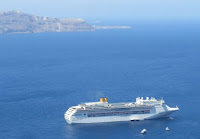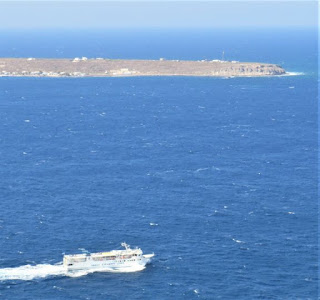The Greek island of Santorini is one of the Cyclades archipelago. It has a small resident population numbering around 25,000 people, but that number is dwarfed by visiting tourists, numbering around 2 million a year. I visted Santorini in September 2019.
Santorini has a network of bus services, provided by KTEL Santorini.
 I found almost all of the vehicles operating Santorini's bus network were coaches.
I found almost all of the vehicles operating Santorini's bus network were coaches.In most cases, they could be identified as operating local bus services by a green and yellow label at the bottom of the windscreen.
Destination displays were boards carried in the windscreen.








I did find one solitary bus operating alongside the coaches.
 The bus network radiates from a central hub in Fira, the main town on Santorini.
The bus network radiates from a central hub in Fira, the main town on Santorini.The bus terminal is an open yard, with passengers and vehicles mingling freely.


At the time of writing, fares on KTEL's bus services range from €1.80 to €2.50, depending on the distance travelled. Fares are collected by a conductor travelling on board the vehicle.
As far as I can tell, there is no through fares if your journey involves a change of bus. You simply buy a new ticket on board the second vehicle.
Santorini has experienced a surge in tourism in recent years. While this may bring welcome revenue to the island, it also brings challenges putting pressure on Santorini's infrastructure.
 The bus service was not immune from this pressure, with congested roads preventing services from keeping to the timetable while high passenger numbers put pressure on capacity.
The bus service was not immune from this pressure, with congested roads preventing services from keeping to the timetable while high passenger numbers put pressure on capacity.This image shows the queue of passengers at Oia, at the north western tip of the island, waiting to board buses to Fira one afternoon.

Once source of visitors to Santorini is cruise ships which call in on tours of the Aegean and Mediterranean seas.



One of the things which draws visitors to Santorini is its sunsets.

The settlements along Santorini's western coast are perched on top of cliffs.
Fira, in this image, is up to 400 metres above the sea.
 Visiting cruise ships anchor in the bay. Passengers are transferred to shore using small boats. Since 1982, a cable car has linked the shore with the town of Fira.
Visiting cruise ships anchor in the bay. Passengers are transferred to shore using small boats. Since 1982, a cable car has linked the shore with the town of Fira.The cable car operates all year round, although operating hours during the winter period are fairly limited and may be affected by planned maintenance work.
Rather than having a continuous rotation of individual cabins, Santorini's cable car operates with two pairs of six cabins, with one pair counterbalancing the other.





 Prior to the opening of the cable car, the only way up from the shore to the town was up steep steps.
Prior to the opening of the cable car, the only way up from the shore to the town was up steep steps.The traditional way of carrying luggage and bulky items was for them to be carried by mule. Mules are still used, not only in Fira but also in Oia.
Regulations are now being introduced to protect the welfare of these animals, which have previously endured long days with little or no access to food, water or shade.


 As well as visiting cruise ships, Santorini is served by a number of scheduled ferry routes connecting the Greek islands with each other, and with Athens.
As well as visiting cruise ships, Santorini is served by a number of scheduled ferry routes connecting the Greek islands with each other, and with Athens.Companies providing sailings to and from Santorini include SeaJets, Golden Star Ferries, Blue Star Ferries, Hellenic Seaways and Small Cyclades Lines.







Whereas the cruise ships anchor in the bay, the scheduled ferries serve Santorini's port, a little way to the south of Fira.


The port is connected to the island's road network. The road to and from the port is carved into the cliffside, climbing with several hairpin bends.
The road can be made out in the image below.


KTEL's bus network includes a service linking Fira with the port (and, for that matter, between Fira and the airport).
An advantage of using coaches is that the vehicles have space for passengers' luggage.


As well as the scheduled bus service, chartered coaches also meet scheduled ferry services at the port.

This is a view of coaches climbing from the port having met an incoming ferry.
 The influx of visitors from cruise ships and scheduled ferries does provide work for Santorini's coach tour operators.
The influx of visitors from cruise ships and scheduled ferries does provide work for Santorini's coach tour operators.


 Tourism also provides custom for smaller boat operators. As well as ferrying cruise passengers from ship to shroe and back, boat operators also offer excursions from smaller harbours along Santorini's shore.
Tourism also provides custom for smaller boat operators. As well as ferrying cruise passengers from ship to shroe and back, boat operators also offer excursions from smaller harbours along Santorini's shore.These images were taken in Fira and Oia.





This vessel (right) might have masts, but the lack of sails gives away that it is powered by a motor.

Finally, Santorini's sunsets provide business for the boat operators. This view shows some of the vessels congregating off Oia as the sun set.



No comments:
Post a Comment